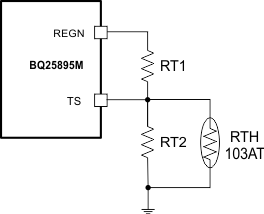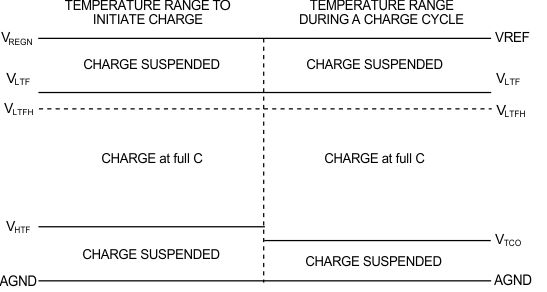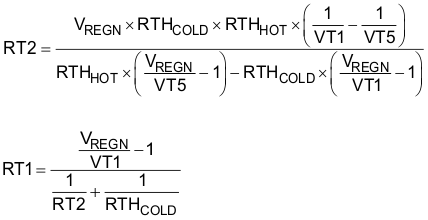ZHCSDX5C July 2015 – October 2022 BQ25895M
PRODUCTION DATA
- 1 特性
- 2 应用
- 3 说明
- 4 Revision History
- 5 说明(续)
- 6 Pin Configuration and Functions
- 7 Specifications
-
8 Detailed Description
- 8.1 Functional Block Diagram
- 8.2
Feature Description
- 8.2.1 Device Power-On-Reset (POR)
- 8.2.2 Device Power Up from Battery without Input Source
- 8.2.3 Device Power Up from Input Source
- 8.2.4 Input Current Optimizer (ICO)
- 8.2.5 Boost Mode Operation from Battery
- 8.2.6 Power Path Management
- 8.2.7 Battery Charging Management
- 8.2.8 Battery Monitor
- 8.2.9 Status Outputs (STAT, and INT)
- 8.2.10 BATET (Q4) Control
- 8.2.11 Current Pulse Control Protocol
- 8.2.12 Input Current Limit on ILIM
- 8.2.13 Thermal Regulation and Thermal Shutdown
- 8.2.14 Voltage and Current Monitoring in Buck and Boost Mode
- 8.2.15 Battery Protection
- 8.2.16 Serial Interface
- 8.3 Device Functional Modes
- 8.4 Register Maps
- 9 Application and Implementation
- 10Power Supply Recommendations
- 11Layout
- 12Device and Documentation Support
- 13Mechanical, Packaging, and Orderable Information
8.2.7.5.1 Cold/Hot Temperature Window in Charge Mode
The device continuously monitors battery temperature by measuring the voltage between the TS pins and ground, typically determined by a negative temperature coefficient thermistor (NTC) and an external voltage divider. The device compares this voltage against its internal thresholds to determine if charging is allowed. To initiate a charge cycle, the battery temperature must be within the VLTF to VHTF thresholds. During the charge cycle the battery temperature must be within the VLTF to VTCO thresholds, else the device suspends charging and waits until the battery temperature is within the VLTF to VHTF range.
 Figure 8-6 TS
Resistor Network
Figure 8-6 TS
Resistor NetworkWhen the TS fault occurs, the fault register REG0C[2:0] indicates the actual condition on each TS pin and an INT is asserted to the host. The STAT pin indicates the fault when charging is suspended.
 Figure 8-7 TS Pin Thermistor Sense Thresholds
Figure 8-7 TS Pin Thermistor Sense ThresholdsAssuming a 103AT NTC thermistor on the battery pack as shown in Figure 8-6, the value RT1 and RT2 can be determined by using Equation 2:

Select 0°C to 45°C range for Li-ion or Li-polymer battery,
RTHCOLD = 27.28 kΩ
RTHHOT = 4.91 kΩ
RT1 = 5.21 kΩ
RT2 = 29.87 kΩ